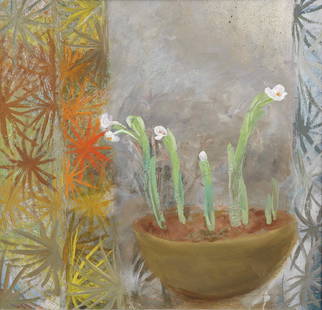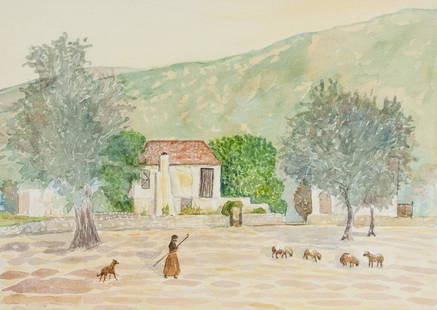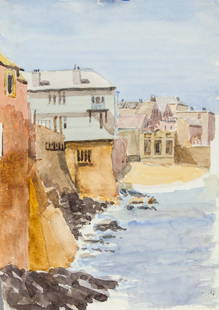
Ben Nicholson (British, 1894-1982) Etching 1966 Print
Ben Nicholson Sale History
View Price Results for Ben Nicholson
Related Paintings
More Items from Ben Nicholson
View MoreRecommended Art
View More






Item Details
Description
Ben Nicholson (British, 1894-1982) Etching Print. Title - Forms in a Landscape 1966. Etching. Signed and dated 66 also signed 40/50 under the mat. Impression measures 7.7 inches high, 8.5 inches wide. Sheet size 12.4 inches high, 12.7 inches wide. Frame measures 14.5 inches high, 15.5 inches wide. In good condition. Tape hinged at top, not laid down.
From Askart: Ben Nicholson was born in 1894 in Denham, Buckinghamshire, England. He was the eldest son of artist Sir William Nicholson. His mother, Mabel Pryde, whose specialty, still life, was conservative and visually literate. His first real contact with modern art was when he saw a Picasso in Paris in the 1920s. His first cubist paintings were tentative. Nicholson did not apply himself seriously to painting until his marriage to Winifred Dacre (Roberts) in 1920. He worked in close collaboration with his wife. About 1930 he began to share a studio with Barbara Hepworth who became his second wife. In 1951 his marriage to Hepworth ended, and in 1957 he married Felicitas Vogler. The most celebrated English painter of his generation, Nicholson formulated his style on the tenets of Synthetic Cubism, and he never deviated far from the standards he had set for himself as a young man as his art moved from illusionary shallow space to shallow relief. His work in the 1930s was severely geometric white reliefs, under the spell of Constructivism and Mondrian. It is not surprising that Nicholson remembered having an astonishing feeling of quiet and repose after meeting Mondrian in the 1930s, for the artists shared a passion for equilibrium. In 1939, he went to live in Cornwall, where the light and influence of landscape became an evident part of his work. In 1958 he and his wife moved to Switzerland. He never completely abandoned figurative work but he stands out as one of the most original exponents of Geometric Abstraction. He died in 1982 in London. Written and submitted by Jean Ershler Schatz, artist and researcher from Laguna Woods, California.
Biography from Bonhams Bond Street 'Think of them, for the moment, not as "pictures" but as "objects" – objects possessing a certain kind of life, objects absorbing and giving back life. If you start hanging a few abstract Nicholsons in a room you will soon find how powerful this life is. You will not be satisfied merely to hang the paintings at the salient points in the room: they will suggest their own positions, and wherever you place them they will have their own influence on the room. They become parts of the space you live in. The "identity between canvas and idea" has become absolute: painting crosses the conventional boundary between "art" and "life"'. (John Summerson, Ben Nicholson, Penguin Books, London 1948, p.10) The white reliefs begun by Ben Nicholson in 1934 and which he continued to produce through the 1930s are widely regarded as one of the most significant steps in English Modernism. One of these was exhibited for the first time in New York, at the Museum of Modern Art, in their 1936 show Cubism and Abstract Art. MoMA's Director at that time and organizer of the exhibition, Alfred Barr, has been compared to Sir Herbert Read in terms of his support and promotion of modern art. And he regarded both Henry Moore and Ben Nicholson as the foremost protagonists of Modernism in Britain during the 1930s. This was an important year therefore for Ben Nicholson's exposure to the international art world, one which helped to establish his reputation as one of the leading intellectual lights of pure abstraction. Nicholson had flirted with abstraction early on in his career. Of the few known canvases, 1924 (trout) (private collection) is undoubtedly the most inspired and successful. Along with 1924 (first abstract painting – Chelsea) (Tate collection) and 1924 (first abstract painting – Andrew)(private collection) their routes lie in the Cubist paintings Nicholson saw in Paris with his first wife Winifred during journeys to and from their home at Lake Lugano in Switzerland. They are evidence of Nicholson's early determination to break from the traditional methods of still life painting he had inherited from his artist father Sir William Nicholson. Although the phase was short-lived, probably owing to their negative criticism in the press at the time, their influence on the artist's psyche were immense. This can be seen when considering 1936 (gouache) in the context of these brief forays into abstraction. The organization of squares and rectangles, and indeed the choice of colours, in Benedict's work strongly recalls those in 1924 (trout). The punchy note of red upper right in the latter has been enlarged and centered in the present work so that it commands the entire composition, and the neighboring colors are all subordinate to it. Twelve years had passed between the execution of the two and Ben Nicholson had grown in stature and more importantly confidence. This can be seen by the prefect harmonies at play in 1936 (gouache) and the different, more refined picture surface, as Jeremy Lewison notes: 'Like the white reliefs, however, the geometric paintings of the late thirties eschewed surface incident and maintained a smooth impasto. This was the only time in Nicholson's career when he did not favour a highly textured, weathered surface, presumably in order to depersonalise and purify the work so that colour and form became the subject. (Jeremy Lewison, Ben Nicholson, Phaidon Press, London 1991, p.18).Ben Nicholson viewed the design and color scheme of 1936 (gouache) as among the most satisfying he produced. Their genesis, for it is noted on the backboard of Benedict's gouache that his was version three out of twelve, lie in the oil painting of the same size and date now in the collection of the Philadelphia Museum of Art. It is not known, however, whether the artist completed all twelve examples. The oil prototype was purchased directly from Nicholson by Albert Gallatin for his Museum of Living Art at New York University, which was to be America's first ever institution exclusively devoted to contemporary art. Gallatin's archives contain an illustrated letter from Nicholson (transcribed below) remarking that the composition is 'one of the best paintings' he had executed. The work was transferred in 1945 to the Philadelphia Museum of Art.Feb 16 (1939)
From Askart: Ben Nicholson was born in 1894 in Denham, Buckinghamshire, England. He was the eldest son of artist Sir William Nicholson. His mother, Mabel Pryde, whose specialty, still life, was conservative and visually literate. His first real contact with modern art was when he saw a Picasso in Paris in the 1920s. His first cubist paintings were tentative. Nicholson did not apply himself seriously to painting until his marriage to Winifred Dacre (Roberts) in 1920. He worked in close collaboration with his wife. About 1930 he began to share a studio with Barbara Hepworth who became his second wife. In 1951 his marriage to Hepworth ended, and in 1957 he married Felicitas Vogler. The most celebrated English painter of his generation, Nicholson formulated his style on the tenets of Synthetic Cubism, and he never deviated far from the standards he had set for himself as a young man as his art moved from illusionary shallow space to shallow relief. His work in the 1930s was severely geometric white reliefs, under the spell of Constructivism and Mondrian. It is not surprising that Nicholson remembered having an astonishing feeling of quiet and repose after meeting Mondrian in the 1930s, for the artists shared a passion for equilibrium. In 1939, he went to live in Cornwall, where the light and influence of landscape became an evident part of his work. In 1958 he and his wife moved to Switzerland. He never completely abandoned figurative work but he stands out as one of the most original exponents of Geometric Abstraction. He died in 1982 in London. Written and submitted by Jean Ershler Schatz, artist and researcher from Laguna Woods, California.
Biography from Bonhams Bond Street 'Think of them, for the moment, not as "pictures" but as "objects" – objects possessing a certain kind of life, objects absorbing and giving back life. If you start hanging a few abstract Nicholsons in a room you will soon find how powerful this life is. You will not be satisfied merely to hang the paintings at the salient points in the room: they will suggest their own positions, and wherever you place them they will have their own influence on the room. They become parts of the space you live in. The "identity between canvas and idea" has become absolute: painting crosses the conventional boundary between "art" and "life"'. (John Summerson, Ben Nicholson, Penguin Books, London 1948, p.10) The white reliefs begun by Ben Nicholson in 1934 and which he continued to produce through the 1930s are widely regarded as one of the most significant steps in English Modernism. One of these was exhibited for the first time in New York, at the Museum of Modern Art, in their 1936 show Cubism and Abstract Art. MoMA's Director at that time and organizer of the exhibition, Alfred Barr, has been compared to Sir Herbert Read in terms of his support and promotion of modern art. And he regarded both Henry Moore and Ben Nicholson as the foremost protagonists of Modernism in Britain during the 1930s. This was an important year therefore for Ben Nicholson's exposure to the international art world, one which helped to establish his reputation as one of the leading intellectual lights of pure abstraction. Nicholson had flirted with abstraction early on in his career. Of the few known canvases, 1924 (trout) (private collection) is undoubtedly the most inspired and successful. Along with 1924 (first abstract painting – Chelsea) (Tate collection) and 1924 (first abstract painting – Andrew)(private collection) their routes lie in the Cubist paintings Nicholson saw in Paris with his first wife Winifred during journeys to and from their home at Lake Lugano in Switzerland. They are evidence of Nicholson's early determination to break from the traditional methods of still life painting he had inherited from his artist father Sir William Nicholson. Although the phase was short-lived, probably owing to their negative criticism in the press at the time, their influence on the artist's psyche were immense. This can be seen when considering 1936 (gouache) in the context of these brief forays into abstraction. The organization of squares and rectangles, and indeed the choice of colours, in Benedict's work strongly recalls those in 1924 (trout). The punchy note of red upper right in the latter has been enlarged and centered in the present work so that it commands the entire composition, and the neighboring colors are all subordinate to it. Twelve years had passed between the execution of the two and Ben Nicholson had grown in stature and more importantly confidence. This can be seen by the prefect harmonies at play in 1936 (gouache) and the different, more refined picture surface, as Jeremy Lewison notes: 'Like the white reliefs, however, the geometric paintings of the late thirties eschewed surface incident and maintained a smooth impasto. This was the only time in Nicholson's career when he did not favour a highly textured, weathered surface, presumably in order to depersonalise and purify the work so that colour and form became the subject. (Jeremy Lewison, Ben Nicholson, Phaidon Press, London 1991, p.18).Ben Nicholson viewed the design and color scheme of 1936 (gouache) as among the most satisfying he produced. Their genesis, for it is noted on the backboard of Benedict's gouache that his was version three out of twelve, lie in the oil painting of the same size and date now in the collection of the Philadelphia Museum of Art. It is not known, however, whether the artist completed all twelve examples. The oil prototype was purchased directly from Nicholson by Albert Gallatin for his Museum of Living Art at New York University, which was to be America's first ever institution exclusively devoted to contemporary art. Gallatin's archives contain an illustrated letter from Nicholson (transcribed below) remarking that the composition is 'one of the best paintings' he had executed. The work was transferred in 1945 to the Philadelphia Museum of Art.Feb 16 (1939)
Condition
Condition is in the description
Buyer's Premium
- 22%
Ben Nicholson (British, 1894-1982) Etching 1966 Print
Estimate $1,000 - $1,500
18 bidders are watching this item.
Shipping & Pickup Options
Item located in St. Petersburg, FL, usSee Policy for Shipping
Local Pickup Available
Payment

TOP





































































